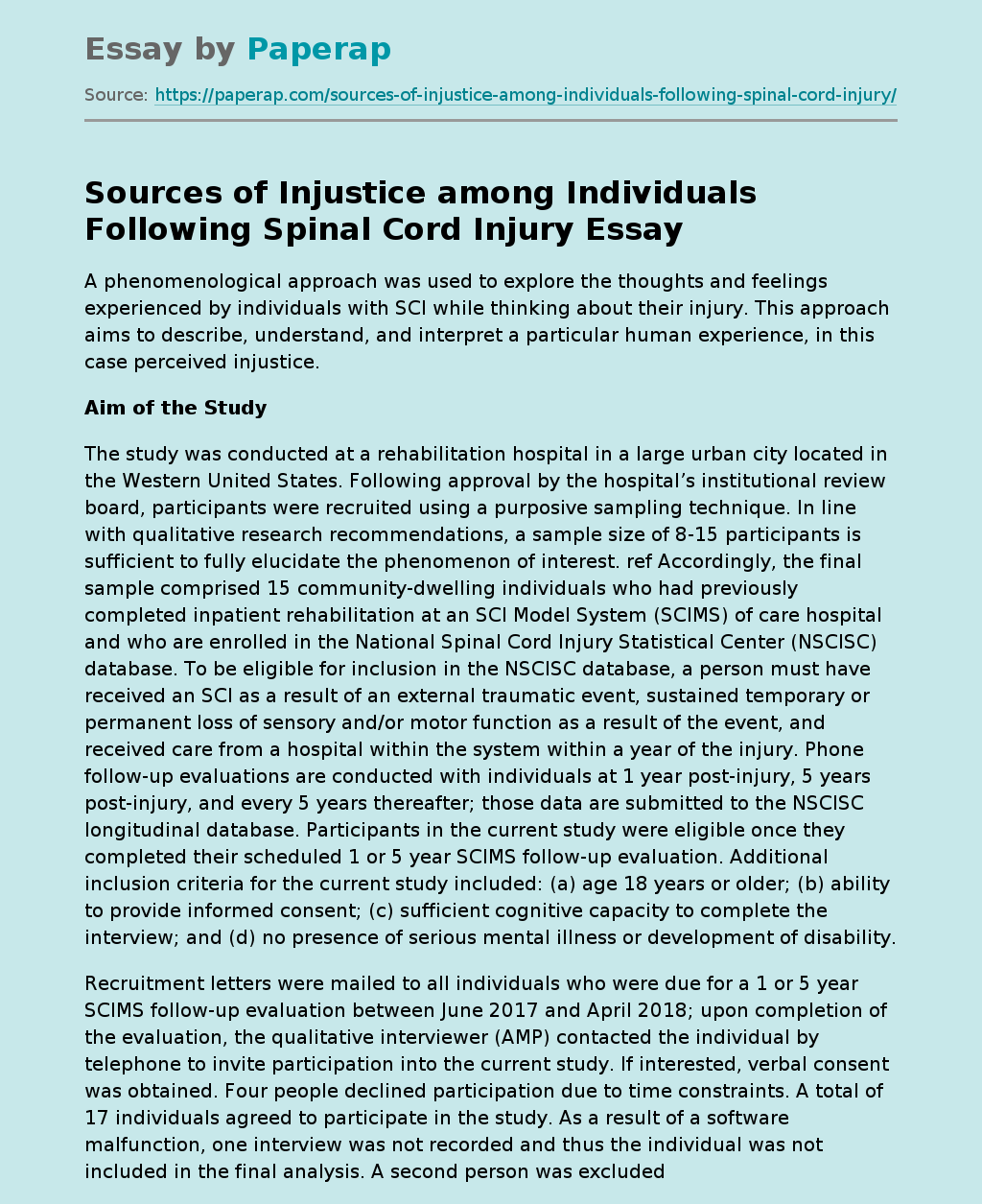Sources of Injustice among Individuals Following Spinal Cord Injury
A phenomenological approach was used to explore the thoughts and feelings experienced by individuals with SCI while thinking about their injury. This approach aims to describe, understand, and interpret a particular human experience, in this case perceived injustice.
Aim of the Study
The study was conducted at a rehabilitation hospital in a large urban city located in the Western United States. Following approval by the hospital’s institutional review board, participants were recruited using a purposive sampling technique. In line with qualitative research recommendations, a sample size of 8-15 participants is sufficient to fully elucidate the phenomenon of interest.
ref Accordingly, the final sample comprised 15 community-dwelling individuals who had previously completed inpatient rehabilitation at an SCI Model System (SCIMS) of care hospital and who are enrolled in the National Spinal Cord Injury Statistical Center (NSCISC) database. To be eligible for inclusion in the NSCISC database, a person must have received an SCI as a result of an external traumatic event, sustained temporary or permanent loss of sensory and/or motor function as a result of the event, and received care from a hospital within the system within a year of the injury.
Phone follow-up evaluations are conducted with individuals at 1 year post-injury, 5 years post-injury, and every 5 years thereafter; those data are submitted to the NSCISC longitudinal database. Participants in the current study were eligible once they completed their scheduled 1 or 5 year SCIMS follow-up evaluation. Additional inclusion criteria for the current study included: (a) age 18 years or older; (b) ability to provide informed consent; (c) sufficient cognitive capacity to complete the interview; and (d) no presence of serious mental illness or development of disability.
Recruitment letters were mailed to all individuals who were due for a 1 or 5 year SCIMS follow-up evaluation between June 2017 and April 2018; upon completion of the evaluation, the qualitative interviewer (AMP) contacted the individual by telephone to invite participation into the current study. If interested, verbal consent was obtained. Four people declined participation due to time constraints. A total of 17 individuals agreed to participate in the study. As a result of a software malfunction, one interview was not recorded and thus the individual was not included in the final analysis. A second person was excluded from the final analysis due to a significant language barrier. The final sample comprised 15 participants. Participant demographic and injury characteristics are displayed in Table 1. Participants were mostly male, white, and unmarried.
Injustice Experience Questionnaire
To assess perceptions of injustice, the 12-item Injustice Experience Questionnaire (IEQ) was administered. For this measure, participants rated the frequency with which they experience 12 thoughts on a five-point scale, ranging from 0 (never) to 4 (all the time). The IEQ has been shown to have high internal reliability and to be valid for use among individuals with musculoskeletal injury (cite). The IEQ generates a total score (between 0 and 48) and loads on two factors: blame/unfairness and severity/irreparability of loss. Following the IEQ, participants took part in an individual, semi-structured interview to explore in greater depth their experiences of injustice following injury. Given the high intercorrelations among IEQ items in previous studies (cite) and to reduce participant burden, a subset of four items were selected from the measure to form the basis of the semi-structured interview. The specific items chosen cover both factors of injustice perceptions, blame/unfairness and severity/irreparability of loss, and include: (1) Most people don’t understand how severe my condition is; (2) I worry that my condition is not being taken seriously; (3) I am suffering because of someone else’s negligence; (4) I feel as if I have been robbed of something very precious. Based on the transcripts of the first three participants, there was no differentiation in responses between the first two items; thus a decision was made to replace the the second item with “I just want to have my life back”. Depending on how the participant responded to each of the selected items, they were asked why the particular statement was either relevant or not relevant to their situation. The interviewer employed follow-up questions or probes to encourage participants to expound on sources of injustice and the contributing factors of injustice perception. Interviews were digitally recorded and transcribed verbatim by the co-investigator (SC). Demographic and injury related variables were abstracted from the most recent SCIMS follow-up evaluation, medical records, or by self-report, where applicable.
Qualitative data analysis involved coding and categorizing the data into themes and subthemes using open, axial, and selective coding as described by Strauss and Corbin.(ref) QSR International’s NVivo 11 Software (ref) was used to conduct the qualitative analysis of the transcripts. Interviews were independently coded by the principal investigator and two co-investigators (KRM, AMP, SC) throughout the course of the study. After coding each transcript, the three analysts met to review themes identified and to discuss topic saturation. Coding disagreements were discussed until consensus was reached on an appropriate code.
Sources of Injustice among Individuals Following Spinal Cord Injury. (2021, Nov 15). Retrieved from https://paperap.com/sources-of-injustice-among-individuals-following-spinal-cord-injury/

